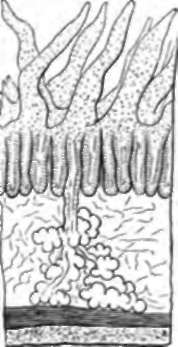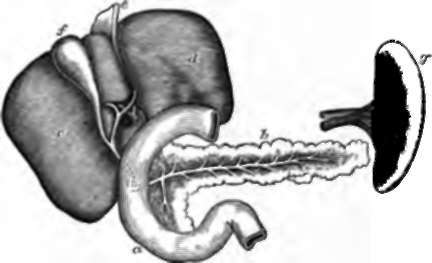70. The Action Of The Fluid Secreted By The Lieberkuhnian Follicles
Description
This section is from the book "Animal Physiology: The Structure And Functions Of The Human Body", by John Cleland. Also available from Amazon: Animal Physiology, the Structure and Functions of the Human Body.
70. The Action Of The Fluid Secreted By The Lieberkuhnian Follicles
The Action Of The Fluid Secreted By The Lieberkuhnian Follicles (succus intestinalis), has been examined by gathering it from the intestines of animals experimented on, and by other means. Like the pancreatic juice, it is an alkaline fluid which acta on starch, oil, and albuminoid matters; but its action is weak compared with that of the gastric and pancreatic juices.

Fig. 66. Duodenum, vertical section magnified, a, Villi; b, Lieber-kuhnian follicles; c, Brunner's gland in the submucous tissue; d, muscular walls.

Fig. 57. Duodenum, Pancreas, Liver, and Spleen. a. Duodenum ; b, pancreas, with the pancreatic duct laid bare; c, d, right and left lobes of the liver, seen from below; e, obliterated umbilical vein; f, gall bladder, opening into the cystic duct which joins with the hepatic duct, to form the ductus communis choledochus; g, spleen.
71. In considering the use of the bile in the intestine, it is necessary to note that the liver, as will be shown in another place, is not a mere preparer of a digestive fluid, and that bile seems rather to be formed in connection with a blood-purifying process in the liver, than as an aid to digestion. The bile is, however, undoubtedly of great service in the absorption of oils. In dogs in which the gall ducts have been shut off from the intestine, and the bile allowed to escape by an external opening, the operation is followed by greatly impaired power of absorbing oils. Indeed, bile is the strongest soap known, ox-gall being on that account used by painters to wash away oil paint; and it seems probable that, by lubricating the villi, the bile assists the minute globules in the emulsion formed by the pancreatic juice to permeate the mucous membrane. Bile is likewise an antiseptic, and prevents the putrefaction in the contents of the intestine, which always takes place when its flow is prevented. But, in addition to all this, it is to be observed that, in health, the essential constituents of the bile are not to be found in the faeces, only the colouring matter is left; also, dogs from -which the bile is abstracted by a fistulous opening, are remarkably ravenous. These facts seem to point out that the bile, which acts as a narcotic poison when introduced unchanged into the blood, is decomposed in the intestine, and gives rise to innocuous products, which are reabsorbed to nourish the body. The seat of this decomposition appears to be the great intestine ; for there the bile disappears, and various substances are found which are obviously derived from its constituents. Of these, two are crystalline, viz., excretin, a carbonaceous substance containing sulphur (Marcet), and stercorin, a body derived from cholesterin (Flint).
Continue to:
